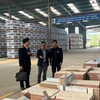Businesses from the wood and rubber sectors are looking to reach agreements for their mutual benefit.
Such a trend is taking place because the wood processing industry is encountering material shortages while the rubber industry is seeking more markets due to price reductions.
According to the General Department of Customs, by the end of April, Vietnam exported 252,416 tonnes of rubber worth about 360.67 million USD.
The figures represented a year-on-year rise of 33.9 percent in volume but a decline of 3.3 percent in value against the same period last year.
Notably, the average price for export rubber in the first four months of this year stood at 1,429 USD per tonne, down up to nearly 28 percent.
In fact, the price of rubber has strongly declined in recent years, from about 5,000 USD per tonnes in 2011 to over 1,400 USD per tonnes at present.
Businesses, therefore, have to take into account a number of measures to overcome the current difficulties. One of the effective solutions is to focus on rubber wood processing.
The volume of rubber wood for processing is increasing, said Tran Thi Thuy Hoa, Office Manager of the Vietnam Rubber Association, adding that the Vietnam Rubber Industry Group will exploit 8-9 million cubic metres of timber from about 30,000 ha of rubber trees which could not produce latex.
Meanwhile, the wood processing industry has seen strong but unsustainable growth due to a lack of material.
Vietnam imports timber from 60-70 nations around the world and mainly from the US, Laos, Cambodia and the EU, according to Vice Chairman cum Secretary General of the Vietnam Wood and Forestry Product Association, Nguyen Ton Quyen.
In that context, the cooperation between the wood and rubber sectors is expected to benefit the two sides. Many businesses from the two sectors have shown their good will to shake hands on such collaboration.
This is also seen as an effective solution since Vietnamese-made home decorations made of rubber wood are popular in the US and Japan.
Normally, a rubber tree could be extracted for latex for about 18-25 years. After that, businesses will start to exploit rubber wood and conduct recultivation.
Therefore, if it is possible to set up a strong connection between the wood and rubber sectors, the wood processing businesses will have a stable source of material while the rubber partners will have a stable source of revenue.-VNA
Such a trend is taking place because the wood processing industry is encountering material shortages while the rubber industry is seeking more markets due to price reductions.
According to the General Department of Customs, by the end of April, Vietnam exported 252,416 tonnes of rubber worth about 360.67 million USD.
The figures represented a year-on-year rise of 33.9 percent in volume but a decline of 3.3 percent in value against the same period last year.
Notably, the average price for export rubber in the first four months of this year stood at 1,429 USD per tonne, down up to nearly 28 percent.
In fact, the price of rubber has strongly declined in recent years, from about 5,000 USD per tonnes in 2011 to over 1,400 USD per tonnes at present.
Businesses, therefore, have to take into account a number of measures to overcome the current difficulties. One of the effective solutions is to focus on rubber wood processing.
The volume of rubber wood for processing is increasing, said Tran Thi Thuy Hoa, Office Manager of the Vietnam Rubber Association, adding that the Vietnam Rubber Industry Group will exploit 8-9 million cubic metres of timber from about 30,000 ha of rubber trees which could not produce latex.
Meanwhile, the wood processing industry has seen strong but unsustainable growth due to a lack of material.
Vietnam imports timber from 60-70 nations around the world and mainly from the US, Laos, Cambodia and the EU, according to Vice Chairman cum Secretary General of the Vietnam Wood and Forestry Product Association, Nguyen Ton Quyen.
In that context, the cooperation between the wood and rubber sectors is expected to benefit the two sides. Many businesses from the two sectors have shown their good will to shake hands on such collaboration.
This is also seen as an effective solution since Vietnamese-made home decorations made of rubber wood are popular in the US and Japan.
Normally, a rubber tree could be extracted for latex for about 18-25 years. After that, businesses will start to exploit rubber wood and conduct recultivation.
Therefore, if it is possible to set up a strong connection between the wood and rubber sectors, the wood processing businesses will have a stable source of material while the rubber partners will have a stable source of revenue.-VNA



















